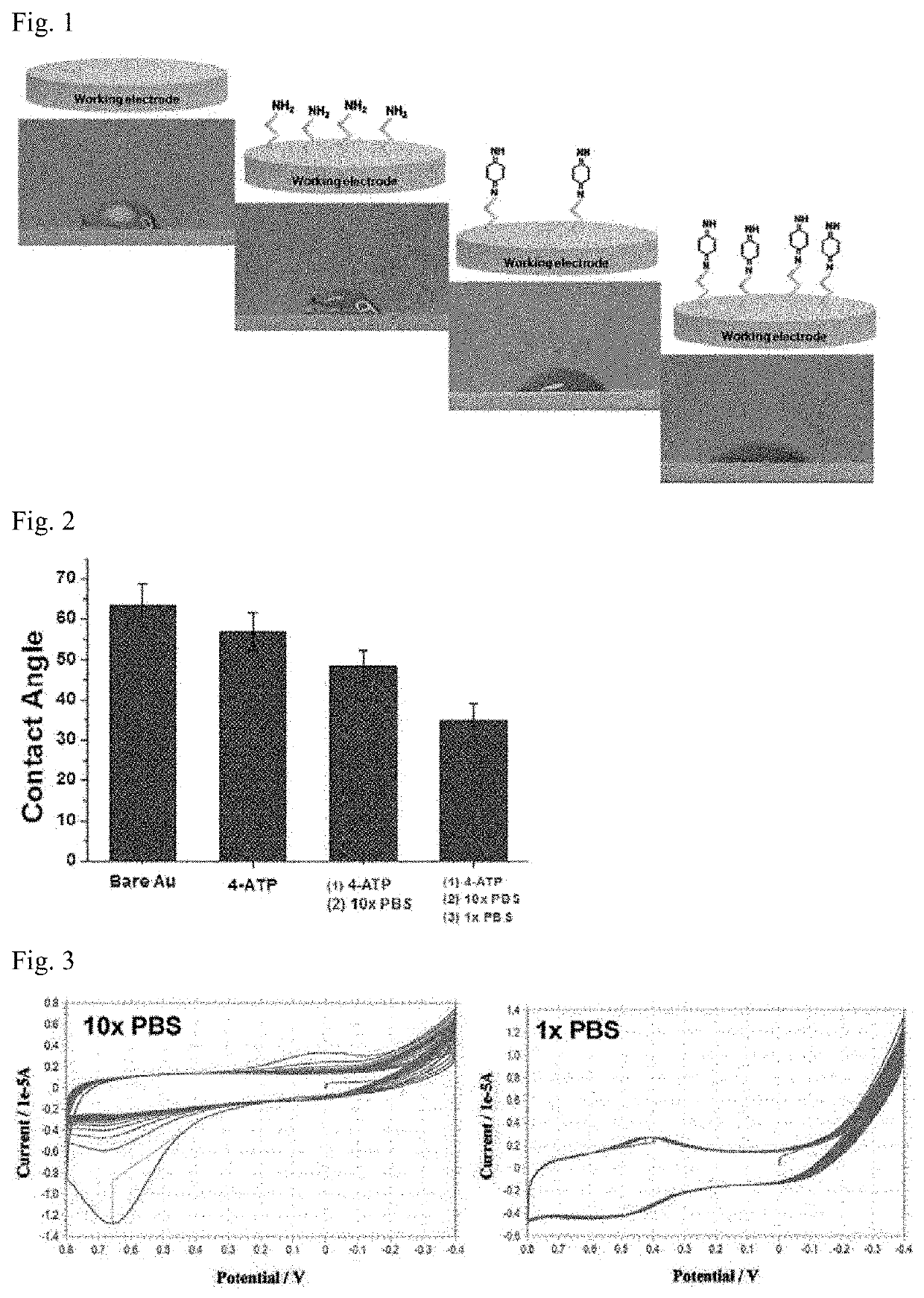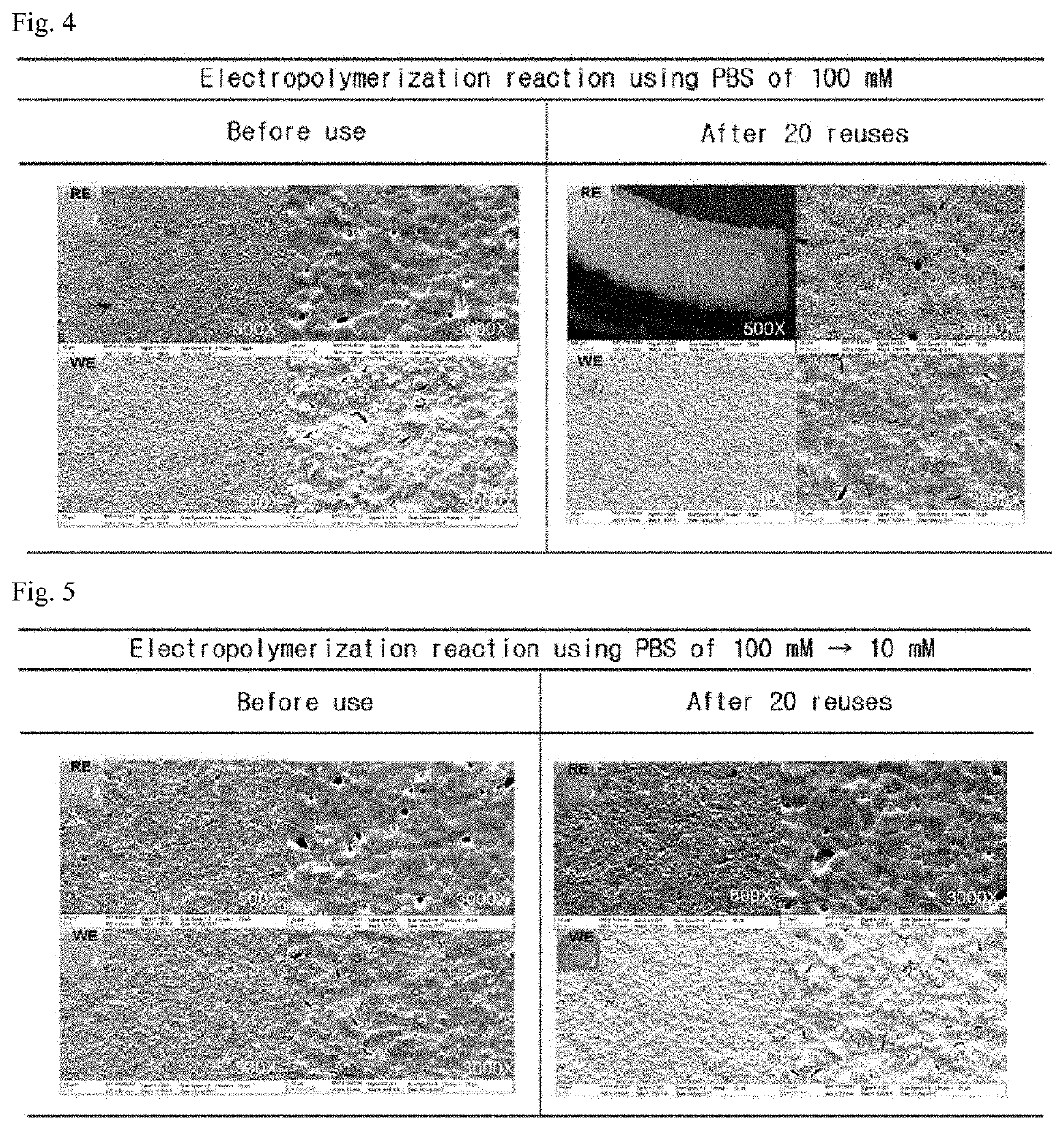Electrode for biosensor for nadh measurement and manufacturing method therefor
a biosensor and electrode technology, applied in the field of electrodes for biosensors, can solve the problems of high sample consumption rate, low sensitivity of nadh measurement in blood, and significant low selectivity, and achieve the effect of increasing the efficiency of surface modification
- Summary
- Abstract
- Description
- Claims
- Application Information
AI Technical Summary
Benefits of technology
Problems solved by technology
Method used
Image
Examples
embodiments
PRODUCTION EXAMPLE
Production of Electrode for Biosensor for NADH Measurement
[0052]An electrode suitable for a biosensor for NADH measurement was produced by performing the following steps.
[0053]A gold (Au) electrode was washed with sulfuric acid (H2SO4) of a molar concentration of 10 mM. Then, in order to form a self-assembled monolayer, the electrode was immersed in 4-aminothiophenol prepared at a molar concentration of 10 mM, and then cultured for 2 hours. Thereafter, N-phenylquinone diimine (hereinafter, referred to as ‘NPQD’) was formed through a process in which the electrode was immersed in a phosphate buffer solution of a molar concentration of 100 mM (high concentration) and then a voltage was swept for a potential between 0.8 V and −0.4 V in cyclic voltammetry. After immersing the electrode having said NPQD formed thereon in a phosphate buffer solution of a molar concentration of 10 mM (low concentration), a process of sweeping a voltage is performed once again by applying ...
embodiment 1
[Embodiment 1] Measurement of Contact Angle of 4-aminothiophenol (4-ATP)
[0055]Changes in the contact angle of NPQD, formed on the surfaces of the electrodes according to Production Example above, were checked. Specifically, after dropping 10 μl of distilled (DI) water on the electrodes of Production Example above at room temperature and humidity condition of 46%, photographs of the respective electrodes were taken, and the measurement and analysis of the contact angle were performed using the method provided by the manufacturer through IMAGE J software, thereby showing the results in FIGS. 1 and 2.
[0056]As shown in FIGS. 1 and 2, NPQD bonded to the surface of Production Example was able to be bonded to the surface in a larger amount, and through this, it can be seen that the surface of the electrode was converted to be more hydrophilic. In particular, as shown in FIG. 2, Comparative Example showed little change in its contact angle compared with the case of bonding only 4-aminothiop...
embodiment 2
[Embodiment 2] Measurement and Comparison of Stabilization of Electric Current Values
[0058]In order to compare whether the phosphate buffer solution of a high concentration (100 mM) and the phosphate buffer solution of a low concentration (10 mM) stabilize electric current values, an electrochemical analysis was performed according to the protocol provided by the manufacturer using a multi-potentiostat device of the CH1040C series, thereby showing the results in FIG. 3.
[0059]As shown in FIG. 3, the measured electric current values were relatively unstable in the phosphate buffer solution of high concentration, whereas the electric current values exhibited a very stable graph in the phosphate buffer solution of 10 mM, corresponding to a low concentration.
[0060]From the above results, it can be seen that performing polymerization reactions in different steps with the conditions of high and low concentrations in producing Production Example in accordance with the present invention lead...
PUM
| Property | Measurement | Unit |
|---|---|---|
| molar concentration | aaaaa | aaaaa |
| molar concentration | aaaaa | aaaaa |
| molar concentration | aaaaa | aaaaa |
Abstract
Description
Claims
Application Information
 Login to View More
Login to View More - R&D
- Intellectual Property
- Life Sciences
- Materials
- Tech Scout
- Unparalleled Data Quality
- Higher Quality Content
- 60% Fewer Hallucinations
Browse by: Latest US Patents, China's latest patents, Technical Efficacy Thesaurus, Application Domain, Technology Topic, Popular Technical Reports.
© 2025 PatSnap. All rights reserved.Legal|Privacy policy|Modern Slavery Act Transparency Statement|Sitemap|About US| Contact US: help@patsnap.com



